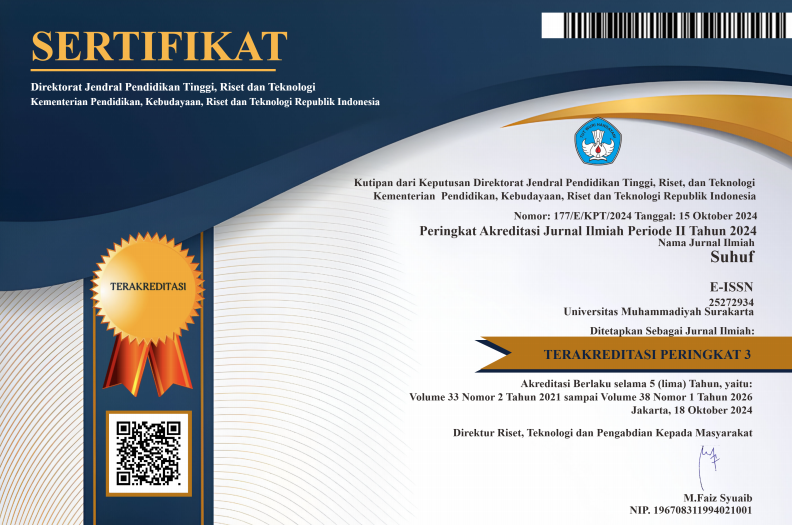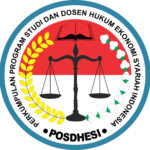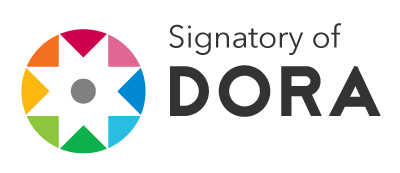Reading Islam in Western Media: Hermeneutic Perspectives and the Hybridity of Southeast Asian Muslim Cultures
DOI:
https://doi.org/10.23917/suhuf.v37i2.11850Keywords:
Western Media, Hermeneutics, Hybrid Culture, Southeast Asian Muslims, Global media landscapeAbstract
This article examines how Islam is represented in Western media and how Southeast Asian Muslim communities interpret and respond to these representations. Using Hans-Georg Gadamer’s philosophical hermeneutics and Homi K. Bhabha’s theory of cultural hybridity, this study explores the intersection between Western media narratives about Islam and the regional cultural contexts of Muslims in Southeast Asia. Representations of Islam in Western media often contain orientalist bias and symbolic simplifications that shape the global public’s perception of Muslims. However, Muslims do not always accept these depictions unquestioningly. Traditionally, Muslims in Southeast Asia have negotiated meaning and constructed new identities that combine Islamic traditions with modern values. This study employs a qualitative–hermeneutic approach by analyzing Western digital media texts including online news outlets (BBC, CNN) and popular audiovisual platforms (Netflix, YouTube) alongside Muslim audience responses collected from social media platforms such as Twitter, Instagram, and TikTok. The findings demonstrate the formation of a dynamic hybrid identity resulting from the interaction between Western media portrayals and Southeast Asian Muslim socio-religious practices in the digital era. This raises epistemological challenges in understanding religious authority and symbolic meaning in online spaces. Therefore, a more critical and contextual approach is needed in rereading the representation of Islam within the global media landscape.
Downloads
References
[1] P. R. Lubis and T. Rambe, “Kesenjangan Pengaliran Arus Informasi Di Dunia Islam [The Gap in the Flow of Information in the Islamic World],” Komunikologi J. Pengemb. Ilmu Komun. dan Sos., vol. 3, no. 2, pp. 113, (Indonesia), Dec. 2019, doi: https://doi.org/10.30829/komunikologi.v3i2.6554.
[2] M. R. Khan, Z. B. M. Zin, and W. F. W. W. Fakhruddin, “Media Representations of Islam and Muslims in Global Contexts (2002-2022): A Systematic Literature Review,” Stud. Media Commun., vol. 13, no. 1, p. 284, Dec. 2024, doi: https://doi.org/10.11114/smc.v13i1.6520.
[3] E. W. Said, Covering Islam: How the Media and the Experts Determine How We See the Rest of the World. Knopf Doubleday Publishing Group, 1997. [Online]. Available: https://books.google.co.id/books?id=zO0deebv7S8C
[4] M. A. Wahid, “From Orientalism to neo-Orientalism: medial representations of Islam and the Muslim world,” Textual Pract., vol. 39, no. 2, pp. 162–181, Feb. 2025, doi: https://doi.org/10.1080/0950236X.2023.2288112.
[5] R. Pun, “Digital Images and Visions of Jihad: Virtual Orientalism and the Distorted Lens of Technology,” CyberOrient, vol. 7, no. 1, pp. 94–115, Jan. 2013, doi: https://doi.org/10.1002/j.cyo2.20130701.0004.
[6] K. Muhajarah and M. E. Soebahar, “Fiqh of tolerance and religious moderation: a study towards Indonesia, Malaysia, and Thailand,” Cogent Arts Humanit., vol. 11, no. 1, pp. 1–11, Dec. 2024, doi: https://doi.org/10.1080/23311983.2024.2303817.
[7] H.-G. Gadamer, Truth and method. A&C Black, 2013. [Online]. Available: https://books.google.co.id/books?hl=en&lr=&id=XaROAQAAQBAJ&oi=fnd&pg=PR3&dq=H.-G.+Gadamer,+Truth+and+method.+A%26C+Black,+2013.&ots=sDXN9Vc1Vg&sig=DYqOlwE3nrDNejqiHH2p09SDoQ4&redir_esc=y#v=onepage&q=H.-G. Gadamer%2C Truth and method. A%26C Black%2C 2013.&f=false
[8] H. K. Bhabha, The location of culture. routledge, 2012. doi: https://doi.org/10.4324/9780203820551.
[9] H.-G. Gadamer and L. Hahn, “The philosophy of Hans-George Gadamer,” Trames, vol. 4, pp. 338–351, 1998, [Online]. Available: https://books.google.co.id/books?hl=en&lr=&id=m4mbvLypbZAC&oi=fnd&pg=PA338&dq=H.-G.+Gadamer+and+L.+E.+Hahn,+The+Philosophy+of+Hans-George+Gadamer.+Chicago,+1997.&ots=gpfxN0iQp9&sig=g2ARuphX8agSaEXBbWynag0pDtY&redir_esc=y#v=onepage&q&f=false
[10] A. Maisyarah and M. Z. Hamzah, “Zakat Distribution Management: A Systematic Literature Review,” Suhuf, vol. 36, no. 1, pp. 95–108, May 2024, doi: https://www.doi.org/10.23917/suhuf.v36i1.4357.
[11] N. Z. N. Zainol, L. A. Majid, and M. F. M. Saad, “An overview on hermeneutics method application to the Quran by Muslim thinkers,” Int. J. Eng. Technol., vol. 7, no. 3.25, pp. 681–684, 2018, [Online]. Available: https://www.researchgate.net/profile/Nur-Zainatul-Nadra-Zainol-2/publication/328189887_An_Overview_on_Hermeneutics_Method_Application_to_the_Quran_by_Muslim_Thinkers/links/5bc1de5e92851c88fd69912a/An-Overview-on-Hermeneutics-Method-Application-to-the-Quran-by-Muslim-Thinkers.pdf
[12] R. Budiarto et al., Fikih Energi Terbarukan - Pandangan Dan Respons Islam Atas Pembangkit Listrik Tenaga Surya (PLTS). 2018. [Online]. Available: https://www.researchgate.net/publication/323254703_Fikih_Energi_Terbarukan_-_Pandangan_Dan_Respons_Islam_Atas_Pembangkit_Listrik_Tenaga_Surya_PLTS/references
[13] J. N. Iwamura, Virtual orientalism: Asian religions and American popular culture. Oxford University Press, 2011. [Online]. Available: https://books.google.co.id/books?id=VYMVDAAAQBAJ&dq=J.+N.+Iwamura,+Virtual+Orientalism:+Asian+Religions+and+American+Popular+Culture.+Oxford+University+Press,+2011.&lr=&source=gbs_navlinks_s
[14] R. Alsaigh and I. Coyne, “Doing a hermeneutic phenomenology research underpinned by Gadamer’s philosophy: A framework to facilitate data analysis,” Int. J. Qual. Methods, vol. 20, pp. 1–10, 2021, doi: https://doi.org/10.1177/16094069211047820.
[15] S. Nemorin, A. Vlachidis, H. M. Ayerakwa, and P. Andriotis, “AI hyped? A horizon scan of discourse on artificial intelligence in education (AIED) and development,” Learn. Media Technol., vol. 48, no. 1, pp. 38–51, 2023, doi: https://doi.org/10.1080/17439884.2022.2095568.
[16] N. Mahmoudi, “The Existential Identity of Creativity in Islamic Philosophy: Intercultural Analysis of the Perfection of the Human Soul,” Din. Ilmu, vol. 23, no. 2, pp. 249–259, Dec. 2023, doi: http://doi.org/10.21093/di.v23i2.6917.
[17] J. A. Ali, “Introduction to Special Issue: Islamic Revivalism and Social Transformation in the Modern World,” Religions, vol. 14, no. 7, p. 899, 2023, doi: https://doi.org/10.3390/rel14070899.
[18] T. Mutia, “Da’wahtainment: the creativity of muslim creators in Da’wah communication on social media,” J. Dakwah Risal., vol. 32, no. 2, p. 147, 2022, doi: https://doi.org/10.24014/jdr.v32i2.15536.
[19] Z. Syarif, A. Hannan, and M. Sulaeman, “New Media Dan Representasi Budaya Islam Populer Di Kalangan Pendakwah Muslim Milenial Di Indonesia [New Media and Representation of Islamic Culture Popular Among Millennial Muslim Preachers in Indonesia],” J. Sosiol. Agama, vol. 17, no. 2, pp. 256–257, (Indonesia), 2023, doi: https://doi.org/10.14421/jsa.2023.172-07.
[20] R. Aditia and E. Hafizah, “Transformation of the Spread of Islamic Messages through the Transition from Traditional Media to Digital Media in Contemporary Da’wah,” J. Al Nahyan, vol. 1, no. 1, pp. 14–23, 2024, doi: https://doi.org/10.58326/jan.v1i1.209.
[21] Nazhifah, “Islam In The West Media Distortion (Media In Constructing Islam As A Terrorist And Extremist Religion),” QAULAN J. Islam. Commun., vol. 2, no. 1, pp. 75–9, Jun. 2021, doi: https://doi.org/10.21154/qaulan.v2i1.2872.
[22] Y. M. Aljamal, “From Radicalism To Tolerance: Media Coverage Of The Muslim World League,” Polit. Relig. J., pp. 95–110, Jun. 2022, doi: 10.54561/prj1601095.
[23] S. Mirzaei, “Hijacking Islam: An Analysis of Positive Representations of Islam and Muslims in the US,” University of Minnesota, 2022. [Online]. Available: https://www.proquest.com/openview/cecdee16d358ffc34632c81617e90820/1?pq-origsite=gscholar&cbl=18750&diss=y
[24] P. D. M. Ahmad, D. H. M. S. Ghani, and D. A. A. Khoso, “The Role of Social Media in Growth of The Muslim Society (An Analytical Study),” Int. Res. J. Manag. Soc. Sci., vol. 2, no. 2, pp. 72–82, Sep. 2021, doi: https://doi.org/10.53575/irjmss.v2.2(21)7.72-82.
[25] A. Ronaldi, A. R. Saidek, and W. Lestari, “New Media as an Ideological Transmission Opportunity for Religious Authorities in Indonesia,” J. Indo-Islamika, vol. 13, no. 2, pp. 90–104, 2023, doi: https://doi.org/10.15408/jii.v13i2.33440.
[26] D. A. Triantoro, F. Husna, R. A. Syahrani, F. Syam, and A. Fitri, “Adaptation of Popular Culture in Digital Fatwa on Social Media,” Islam Realitas J. Islam. Soc. Stud., vol. 9, no. 2, pp. 169–185, 2023, doi: https://doi.org/10.30983/islam_realitas.v9i2.7607.
[27] R. Hidayatullah, “Otoritas Keagamaan Digital: Pembentukan Otoritas Islam Baru di Ruang Digital [Digital Religious Authority: The Establishment of a New Islamic Authority in the Digital Space],” J. Ilmu Ushuluddin, vol. 10, no. 1, pp. 1–12, (Indonesia), 2024, doi: https://doi.org/10.15408/ushuluna.v10i02. 42831.
[28] Abd Hannan and Ach Fatayillah Mursyidi, “Social Media and the Fragmentation of Religious Authority among Muslims in Contemporary Indonesia,” Digit. Muslim Rev., vol. 1, no. 2, pp. 84–104, Nov. 2023, doi: https://doi.org/10.32678/dmr.v1i2.10.
[29] H. Febrian, “Visualizing Authority: Rise of the Religious Influencers on the Instagram,” Soc. Media + Soc., vol. 10, no. 4, Oct. 2024, doi: https://doi.org/10.1177/20563051241286850.
[30] M. S. Al-Zaman, “Social mediatization of religion: islamic videos on YouTube,” Heliyon, vol. 8, no. 3, 2022, [Online]. Available: https://www.cell.com/heliyon/fulltext/S2405-8440(22)00371-1
[31] T. Stevenson, “Explaining Islam to the West,” World Futures, vol. 78, no. 5, 2022, doi: https://doi.org/10.1080/02604027.2021.1976034.
[32] N. Jamil, Faithful Transformations: Islamic Self-Help in Contemporary Singapore. London: University of Illinois Press, 2025. [Online]. Available: https://books.google.co.id/books?id=bcRgEQAAQBAJ&dq=N.+Jamil,+Faithful+Transformations:+Islamic+Self-Help+in+Contemporary+Singapore.+University+of+Illinois+Press,+2025.&lr=&source=gbs_navlinks_s
Downloads
Submitted
Accepted
Published
How to Cite
Issue
Section
License
Copyright (c) 2025 Muhamad Riza Chamadi, Kuntarto Kuntarto, Muhamad Baedowi, Lis Safitri

This work is licensed under a Creative Commons Attribution 4.0 International License.


















